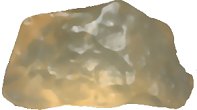
July Editorial
Egyptian desert glass |
|
Egyptians have known and used desert glass for thousands of years, but the origin of the glass is still a mystery. The yellow-green natural glass can be found scattered across a large area of the south-eastern Sahara. Mass spectroscopy reveals that this natural glass contains a largely decreased level of Zircon in relation to Silicon. Zircon is unstable in high temperatures and the level of degradation can be correlated with heat exposure. By looking at the amount of Zircon in samples collected from the Sahara, it was estimated that the sand had to be exposed to surface temperatures of about 1,800oC. These sort of temperatures could not have been created by anything on Earth, since not even volcanic eruptions reach these temperatures. Therefore the cause had to be due to some extraterrestrial impact. Natural glasses created by a large meteorite impact are known b y the generic name of tektites (see the description of Moldavite recently covered in our Rocks in Focus section). Indeed, desert glass closely resembles tektites. However, there is no sign of a crater anywhere to indicate that a meteorite impact happened in that part of the Sahara desert. Scientists believe that if desert glass is the result of a large meteorite impact we should still be able to see it in satellite images. So what else could cause this huge meltdown? One possible explanation is a huge fireball. Until recently, no evidence of such fireballs existed. However, data from the Hubble telescope which was received in 1994 have given us direct evidence that such fireballs can indeed occur in nature. At the time scientists were working with data obtained by watching the comet Shoemaker-Levy as it collided with Jupiter. Parts of the comet exploded in the Jovian atmosphere, and the Hubble telescope recorded the largest incandescent fireball ever witnessed as it rose over Jupiter's horizon. Further computer simulations modelled by a scientist called Mark Boslough have indicated that indeed, a fireball created by exploding rocks in the Earth's atmosphere could raise temperatures to 1,800C, leaving behind a sheath of glass formed by the melted rocks below. Scientists believe that small asteroids may well be the cause of desert glass. Asteroids are composed of loosely compacted rocks. Because these are quite fragile, they would probably disintegrate after entering Earth's atmosphere, creating a fireball without an impact crater. Indeed, computer predictions suggest that the more fragile the incoming object, the more likely these airborne explosions are to happen. So if it happened in Sahara, could it happen again? Mark Boslough believes that the answer is not if but when. |
| _______________________________ | ||||
| Home | | | Shopping | | | Database |
© Biscuit Software 2004-2015
All rights reserved